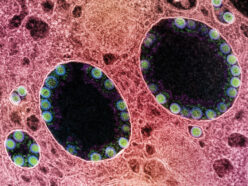
Breathless
David Quammen
Simon & Schuster, $29.99
When COVID-19 burst onto the global stage in 2020, it was deadly and disruptive. In the first weeks of January, researchers identified the cause: A coronavirus was to blame, a relative of the virus that caused the 2003 SARS outbreak. Echoes of what had happened nearly 20 years earlier — thousands were infected and at least 774 people died before the SARS outbreak was brought under control — sent ripples of anxiety throughout the virology world.
Scientists of all backgrounds rushed to understand the new scourge, dubbed SARS-CoV-2. Hospitals around the world were soon overwhelmed, and daily life for billions of people was thrown into disarray. Quarantine, isolation, N95 masks and social distancing entered our collective lexicon. Breathless, by science writer David Quammen, takes readers along on the ensuing two-year scientific roller coaster.
The book is a portrait of the virus — SARS-CoV-2’s early days in China, how decades of science helped researchers craft effective vaccines within a year, the arrival of highly mutated variants. It’s not about the societal upheaval or the public health failures (and successes). While Quammen acknowledges the importance of those aspects of the pandemic, he chooses to focus on the “firehose” of scientific studies — both good and bad — that drove our understanding of COVID-19.
He dives deep into one of the pandemic’s most controversial questions: Where did SARS-CoV-2 come from? Nature or the lab? Quammen describes the saga in elaborate detail. First there were worries that some of the virus’s features appeared engineered. Those concerns were quickly dispelled when researchers found those features in viruses from wild bats and pangolins. Then there was the thought that workers in a lab studying bat viruses could have become accidentally infected and unknowingly spread the virus to others.
Rather than dismiss that accidental lab leak hypothesis, Quammen takes readers step by step through the genetic and epidemiological data. That includes recent evidence supporting the scenario that the virus emerged — perhaps in two separate jumps — from an unknown animal at the Huanan Seafood Wholesale Market in Wuhan, China. Through his conversations with experts in virus ecology and evolution, readers learn the nuances of how virologists do research and the controversies of gain-of-function studies that test what happens when viruses acquire new traits. Quammen’s conclusion: An accidental lab leak is not impossible. “But it seems unlikely.”
To understand the pandemic, Quammen draws on lessons learned from our previous run-ins with coronaviruses, including the SARS outbreak and the 2012 MERS outbreak in the Middle East (SN: 12/28/13, p. 23). Part of his 2012 book Spillover focused on the bat origin of the SARS outbreak (SN: 10/20/12, p. 30). That tome is unnervingly prescient. If the original SARS coronavirus had been most contagious before symptoms began, Quammen wrote in Spillover, officials would have had a much harder time ending the outbreak. “It would be a much darker story,” he wrote. But that’s exactly what happened with SARS-CoV-2. People can pass the virus to others before knowing they are sick, a trait that helped COVID-19 spiral out of control.
As a science journalist who has followed SARS-CoV-2 since its discovery, I found Breathless to be surprisingly cathartic. My memories of the last few years have blurred together. Breathless presents the sweeping scientific story of the pandemic, connecting puzzle pieces that at the time had felt so out of place.
Some readers may feel it’s too soon to scrutinize a pandemic that isn’t even over. But SARS-CoV-2 certainly won’t be the last harmful virus to emerge. Quammen puts the pandemic in the context of the coronavirus scares that came before to highlight how science builds on itself. And one thing is certain: There will be another. “There are many more fearsome viruses where SARS-CoV-2 came from,” he writes, “wherever that was.”
Buy Breathless from Bookshop.org. Science News is a Bookshop.org affiliate and will earn a commission on purchases made from links in this article.

 A new treatment could restore some mobility in people paralyzed by strokes
A new treatment could restore some mobility in people paralyzed by strokes  What has Perseverance found in two years on Mars?
What has Perseverance found in two years on Mars?  This robot automatically tucks its limbs to squeeze through spaces
This robot automatically tucks its limbs to squeeze through spaces  Greta Thunberg’s new book urges the world to take climate action now
Greta Thunberg’s new book urges the world to take climate action now  Glassy eyes may help young crustaceans hide from predators in plain sight
Glassy eyes may help young crustaceans hide from predators in plain sight  A chemical imbalance doesn’t explain depression. So what does?
A chemical imbalance doesn’t explain depression. So what does?